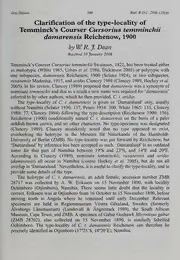
Clarification of the type-locality of Temminck's Courser Cursorius temminckii damarensis Reichenow, 1900 PDF
Preview Clarification of the type-locality of Temminck's Courser Cursorius temminckii damarensis Reichenow, 1900
GuyDutson 309 Bull. B.O.C. 2006126(4) Clarification ofthe type-locality of Temminck's Courser Cursortus temminckii damarensis Reichenow, 1900 byWR,J,Dean Received 10January 2006 Temminck's Courser Cursorius temminckii Swainson, 1822, has been treated either as monotypic (White 1965, Urban et al. 1986, Dickinson 2003) or polytypic with one subspecies, damarensis Reichenow, 1900 (Sclater 1924), or two subspecies, ruvanensis Madarasz, 1915, andaridus Clancey 1989 (Clancey 1989, Hockey etal. 2005). In his review, Clancey (1989) proposed that damarensis was a synonym of nominate temminckii andthat as a result a new name was required for 'damarensis' referred to by other authors, which he then provided, C. /. aridus. The type-locality of C. t. damarensis is given as 'Damaraland' only, usually without Namibia (Sclater 1930: 137, Peters 1934: 300, White 1965: 135, Clancey 1980: 77, Clancey 1984) following the type-description (Reichenow 1900: 156). Reichenow (1900) conditionally named C. t. damarensis on the basis of a paler reddish-brown crown, and no other characters. No type-specimen was designated (Clancey 1989). Clancey mistakenly noted that no type appeared to exist, overlooking the holotype in the Museum fur Naturkunde of the Humboldt- University ofBerlin (ZMB). No type-locality was put forward by Reichenow, but 'Damaraland' by inference has been accepted as such. 'Damaraland' is an outdated name for that part of Namibia between 19°S and 23^S, and 14°E and 20°E. According to Clancey (1989), nominate temminckii, ruvanensis and aridus {damarensis) all occur in Namibia {contra Hockey et al. 2005), but do not all overlap in 'Damaraland.'Nevertheless, itisuseful to clarifythetype-locality, andto provide some details ofthe type. The holotype of C. t. damarensis, an adult female, accession number ZMB 28717 was collected by A. W. Eriksson on 15 November 1890, with locality Ochimboro (Otjimboro), Namibia. There seems little doubt that the locality is correct. Eriksson was at Otjimboro from 16 October to 15 November 1890, before moving north to Angola where he remained until early December. Relevant specimens are held in Regionmuseum Vostra Gotaland, Sweden (formerly Alvsborgs Lansmuseum) (Lundevall & Angermark 1989), the South African Museum, Cape Town, and ZMB. Aspecimen ofGabar GoshawkMicronisusgabar (ZMB 28702), also collected on 15 November 1890, is similarly labelled Ochimboro. The type-locality of C. t. damarensis Reichenow can therefore be precisely identified as Otjimboro (17"25'S, 18°20'E), Namibia. W.R.J. Dean 310 Bull. B.O.C. 2006126(4) Acknowledgements IthankBobDowsettforsuggestingthatthetype-localitybeclarifiedandforhis coiiunentsonalistof type-specimensinZMB. MyvisittoBerlinwasmadepossiblebyfundingfromtheGlobalBiodiversity InformationFacility,Denmark. IthankSylkeFrahnertatZMB forworkingspaceandaccesstothebird collectionthere. References Clancey,P.A.(ed.) 1980.SAOSchecklistofsouthernAfricanbirds. SouthAfr.Om. Soc,Johannesburg. Clancey, P.A. 1984. Geographicalvariation andpost-breeding dispersal inTemminck's Courserofthe Afrotropics. Gerfaut74: 361-374. Clancey,P.A. 1989.Thestatusof(Cursoriustemminckii)damarensisReichenow, 1901.Bull.Brit. Orn. CI. 109: 51-53. Dickinson, E. C. (ed.) 2003. TheHoward& Moore complete checklistofthe birds ofthe world. Third edn. ChristopherHelm,London Hockey, RA. R., Dean, W. R. J. & Ryan, R G (eds.) 2005. Roberts'birds ofsouthernAfrica. Seventh edn.JohnVoelckerBirdBookFund,CapeTown. Lundevall,C.-F. &Angermark,W. 1989.FdglarfrdnNamibia. AlvsborgsLansmuseum,Vanersborg. Peters,J. L. 1934. Check-listofbirdsoftheworld,vol. 2.HarvardUniv.Press,Cambridge,MA. Reichenow,A. 1900.Die VogelAfrikas,vol. 1. O.Neumann,Neudamm. Sclater,W. L. 1924.SystemaAviumyEthiopicarum. BritishOrnithologists'Union,London. Urban,E.K.,FryC. H. &Keith, S. (eds.) 1986. ThebirdsofAfrica,vol. 2.AcademicPress,London. White,C. M.N. 1965.ArevisedchecklistofAfricannon-passerinebirds. GovernmentPrinter,Lusaka. Address: DST/NRF Centre of Excellence at the Percy FitzPatrick Institute ofAfrican Ornithology, UniversityofCapeTown,Rondebosch, 7701 SouthAfrica,e-mail: [email protected] ©BritishOrnithologists'Club2006 Is the bulbul Phyllastrephus lorenzi a good species? by Lincoln D. C. Fishpool Received 13January 2006 Sassi's OliveGreenbulPhyllastrephus lorenzi Sassi, 1914, is apoorlyknownbulbul (Pycnonotidae) of apparently limited distribution. Originally described from a specimen collected at Moera, near Beni, in eastern Democratic Republic ofCongo, the relatively few subsequent records have been confined to forests ofthis region, with one from adjacent western Uganda. Almost all records refer to collected material, such that virtually nothing is known of the bird in life. So far as I am aware, there are 44 specimens in museums (Table 1). In the course ofpreparing the bulbul familyaccountfortheHandbookofthebirdsoftheworld(Fishpool&Tobias 2005), I examined 40 ofthese. As a result, I have come to the conclusion that P. lorenzi is almost certainly not a valid species but is, rather, synonymous with the widespread Icterine Greenbul P. icterinus, ofwhich it is possibly a melanic morph. I presentherethemorphological evidencethathas ledmetothis conclusiontogether with distributional and other data consistent with such a view.
